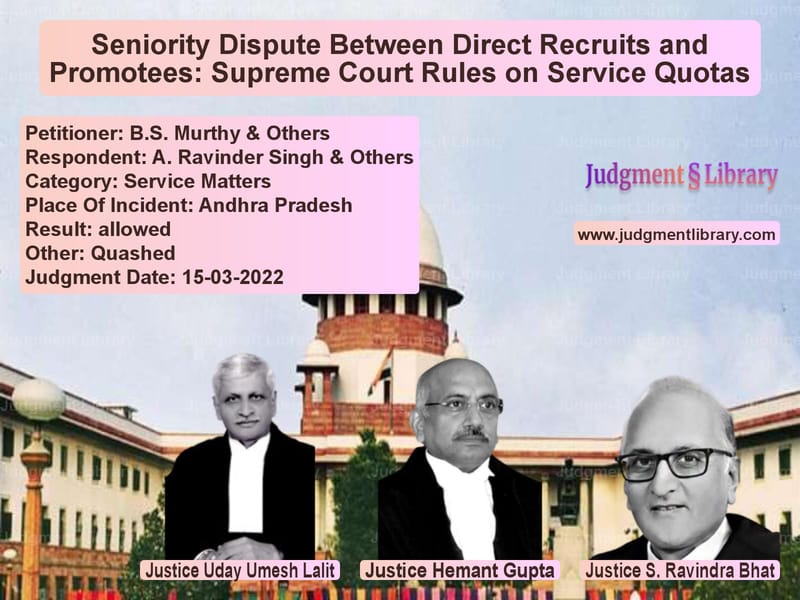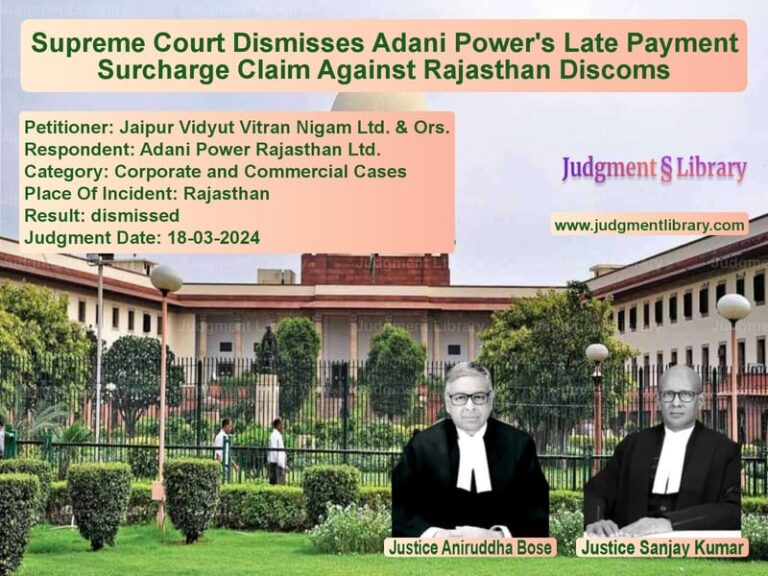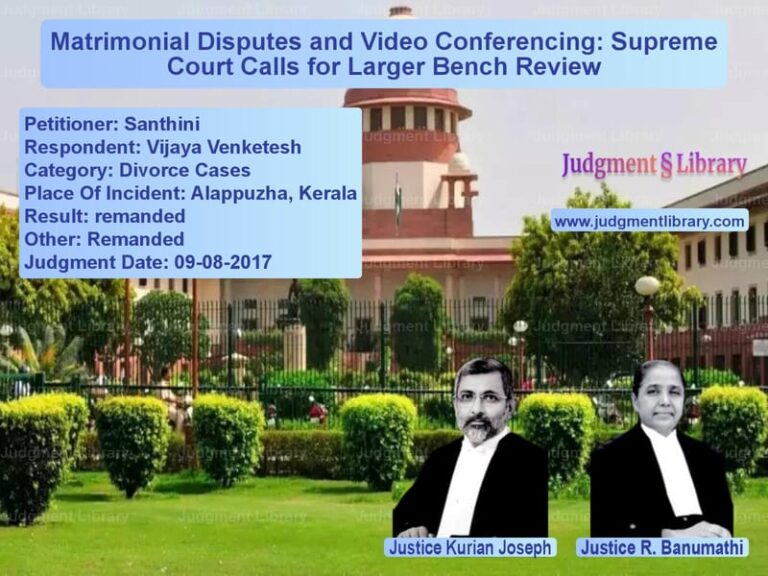Seniority Dispute Between Direct Recruits and Promotees: Supreme Court Rules on Service Quotas
The case of B.S. Murthy & Others vs. A. Ravinder Singh & Others revolves around a longstanding dispute regarding the inter se seniority between direct recruit inspectors (DRIs) and promotee inspectors (PRIs) in the Central Excise Department. The primary issue was whether the promotees, who were given regular appointments before the direct recruits, could claim seniority over them, considering that their appointments were made when a government-imposed ban on direct recruitment was in place.
The Supreme Court overturned the Andhra Pradesh High Court’s judgment and ruled in favor of the promotees, reinstating their seniority and directing the department to prepare a fresh seniority list in accordance with established legal principles.
Background of the Case
Recruitment to the post of Inspector of Central Excise occurs through two channels:
- Direct Recruitment (DRIs): 75% quota filled through the Staff Selection Commission (SSC).
- Promotion (PRIs): 25% quota filled through internal promotions.
The dispute arose due to inconsistencies in seniority determination, as the governing Central Excise and Land Customs Group-C Recruitment Rules, 1979 did not provide clear guidance. Instead, executive instructions, such as the Office Memorandums (OMs) issued in 1959 and 1986, were used to fix seniority.
The Core Dispute
The controversy began when a ban on direct recruitment (1984-1990) was imposed by the government. During this period, the department continued to promote eligible candidates within the 25% quota. However, once the ban was lifted, fresh direct recruits were appointed. The department then retrospectively applied the 1986 OM, treating promotees as ad-hoc appointees and pushing them down in seniority below the newly recruited DRIs.
Promotees challenged this decision before the Central Administrative Tribunal (CAT), which ruled in their favor. The department, along with some direct recruits, appealed before the High Court of Andhra Pradesh, which set aside CAT’s decision. The promotees then moved the Supreme Court.
Arguments of the Petitioner (Promotees)
The promotees, represented by Senior Counsel R. Basant, argued:
- The government’s decision to retrospectively apply the 1986 OM was erroneous.
- All promotions during the ban period were made within the 25% quota, as confirmed by official vacancy registers.
- The ban on direct recruitment did not apply to promotions, meaning the department had the authority to promote within the quota.
- The retrospective application of the 1986 OM unfairly disadvantaged promotees by placing them below DRIs who joined much later.
- The vacancy register clearly demonstrated that no excess promotions were made.
Arguments of the Respondent (Direct Recruits and Department)
The respondents, represented by Additional Solicitor General Madhavi Divan, countered:
- Since direct recruit vacancies were not reported to the SSC during the ban period, the PRIs’ promotions were excess appointments.
- The 1986 OM mandated that if DRIs were unavailable, promotees should be treated as ad-hoc and placed at the bottom of the seniority list.
- Appointments under compassionate grounds, sports quota, and inter-commissionerate transfers should not be counted as direct recruitment vacancies.
- The High Court correctly upheld the department’s approach to maintaining the quota system.
Supreme Court’s Observations
The Supreme Court, comprising Justices Uday Umesh Lalit, Hemant Gupta, and S. Ravindra Bhat, reviewed the legal framework, official records, and precedents before concluding:
- The 1986 OM was prospective and could not be applied to promotions made before its issuance.
- The vacancy register proved that no excess promotions were made during the 1984-1990 ban period.
- Since direct recruitment was prohibited due to the ban, it was incorrect to assume that PRIs occupied DRIs’ vacancies.
- The department’s claim that quota calculations should be based on requisitions sent to SSC rather than actual vacancies was unjustified.
- The retrospective downgrading of PRIs’ seniority was against Article 14 and Article 16 of the Constitution.
The Court emphasized:
“The retrospective application of the 1986 OM unfairly disadvantages promotees who were appointed within their legal quota, and the seniority lists must be revised accordingly.”
Supreme Court’s Verdict
On March 15, 2022, the Supreme Court ruled:
- The High Court’s decision was set aside.
- The Central Administrative Tribunal’s (CAT) ruling was reinstated.
- A fresh seniority list must be prepared within three months, restoring promotees’ seniority.
- PRIs’ seniority should be counted from their actual date of appointment and not from the date direct recruits were appointed later.
The Court concluded:
“Seniority cannot be given retrospectively to a direct recruit who was not borne in service when a promotee had already been appointed regularly.”
Conclusion
This ruling establishes clear legal principles:
- Seniority must be determined by actual appointment dates, not anticipated vacancies.
- Retrospective application of policies is unfair when it disadvantages employees who were legally appointed.
- Quota rules must be followed based on actual vacancies, not merely requisitions to the SSC.
- Promotions made within quota during a direct recruitment ban remain valid and do not make the appointees ad-hoc.
The Supreme Court’s decision ensures that fairness and constitutional principles govern disputes regarding government service seniority.
Petitioner Name: B.S. Murthy & Others.Respondent Name: A. Ravinder Singh & Others.Judgment By: Justice Uday Umesh Lalit, Justice Hemant Gupta, Justice S. Ravindra Bhat.Place Of Incident: Andhra Pradesh.Judgment Date: 15-03-2022.
Don’t miss out on the full details! Download the complete judgment in PDF format below and gain valuable insights instantly!
Download Judgment: b.s.-murthy-&-others-vs-a.-ravinder-singh-&-supreme-court-of-india-judgment-dated-15-03-2022.pdf
Directly Download Judgment: Directly download this Judgment
See all petitions in Promotion Cases
See all petitions in Recruitment Policies
See all petitions in Public Sector Employees
See all petitions in Judgment by Uday Umesh Lalit
See all petitions in Judgment by Hemant Gupta
See all petitions in Judgment by S Ravindra Bhat
See all petitions in allowed
See all petitions in Quashed
See all petitions in supreme court of India judgments March 2022
See all petitions in 2022 judgments
See all posts in Service Matters Category
See all allowed petitions in Service Matters Category
See all Dismissed petitions in Service Matters Category
See all partially allowed petitions in Service Matters Category







